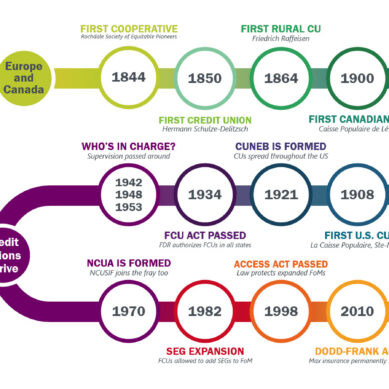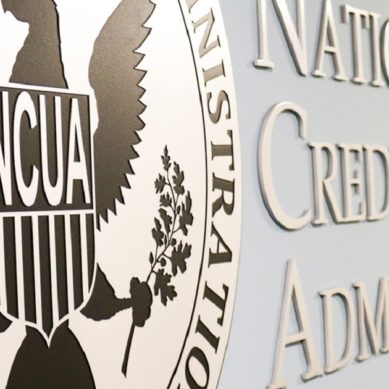In today’s economic climate, the need for financial stability has never been more dire, yet simultaneously has never felt more unattainable. Affordable housing is nearly impossible to find, the cost of groceries is astronomical—rising more than 21% in the last three years (and is expected to continue to climb)—and American credit card balances are setting records.
These rising costs due to inflation coupled with shrinking (or stagnant) salaries have led to the largest increase in those living in poverty on record. From 2021 to 2022, the poverty rate rose from 7.8% to 12.4%, and for children, the poverty rate during this same period doubled, jumping from 5.2% to 12.4%.
It’s no wonder then that 42% of Americans are living on survival budgets and 78% are living paycheck to paycheck. With so many people nationwide and locally in our communities struggling to stay afloat, the right financial partner can make all the difference, and that is where credit unions come in.
With a mindset of people over profit—offering services such as character-based lending, low-interest loans, and financial counseling—credit unions are perfectly positioned to serve as a life vest for struggling families. By creating access to financial resources and putting financial wellness at the center of the credit union and in everything it does, credit unions can help those in their communities find their way to a more financially secure future.
But how can we better work to connect credit unions with the people who need them most and create more opportunities for financial growth? This is exactly the issue cooperative champion and innovator Jamie Strayer set out to tackle throughout her career.
CUSO Magazine sat down with Strayer to learn more about the work she’s doing and how credit unions can better connect with those who need their help and put financial wellness at the heart of the organization.
Get to know Jamie Strayer

Jamie Strayer
Jamie Strayer is a woman of many titles and talents. Founder of CU Strategic Planning, Executive Producer & Creator of the award-winning show Opportunity Knock$, and Co-Owner of the Emmy Award Winning television show Biz Kids, Strayer is fiercely and passionately committed to revolutionizing financial literacy and making financial wellness an attainable goal for as many as possible.
Growing up in the historic cooperative village of Zoar, Ohio, Strayer fell in love with the cooperatives while giving tours of the town with her grandma and witnessing her mother’s work in the unemployment office where she connected those in need with credit unions and nonprofits that could best serve them. Her innovative, spirit, however, she accredits to her uncle, one of the most prolific patent holders in the United States.
With a personal mission to unlock opportunities for credit unions to change lives and their communities, Strayer’s steadfast commitment to cooperatives, serving the underserved, and creating financial opportunities for all was directly inspired by these pivotal figures and experiences, and it was with this drive that Strayer created CU Strategic Planning, a business of CDFI experts she started at her kitchen table that has now won $946 million for credit unions, and The Opportunity Knock$ Initiative.
These projects all work to serve what Strayer believes to be the key to bridging the divide between credit unions and consumers: putting financial wellness at the heart of the credit union by focusing on offering financial education and creating access to financial services and products.
Putting financial wellness at the center of the credit union
But why do we need to bridge a divide at all? Why aren’t consumers reaching out to credit unions as much as we’d hope? Well, for starters, consumers’ trust in financial institutions has never been lower than it is today, and credit unions are not exempt from this. Viewed as out-of-touch and product-focused, consumers don’t feel modern credit unions and banks put their needs above all.
This is the number one hurdle credit unions must overcome, according to Strayer. However, achieving this is incredibly difficult to do, as credit unions are highly regulated financial institutions.
“The only way that it can be effectively done is by redesigning the way in which we interact with consumers by putting their needs first, instead of our products first,” said Strayer. “When you go to credit union websites, the drop-down menu is often just their products, and it is very clear to consumers that credit unions are trying to sell them something.”
The idea of putting financial wellness at the center of everything is not one idea. It involves every component of the credit union including messaging, marketing, product ideas, business development, and financial education.
“Only when consumers’ needs and credit union priorities align, are we relevant to consumers. Then they see that we’re not institutional and out of touch.”
So how do credit unions put members’ needs before products? By focusing on the two elements that make up financial wellness as mentioned earlier: supporting financial education efforts for students and creating access to financial resources for those who are struggling.
Lack of financial education leads to poor habits
The first component of financial wellness is setting members up to develop healthy financial habits and a strong financial future by teaching students these concepts from a young age. This is an important idea we’ve touched on in previous Financial Literacy Months, as credit unions are leading important work in this area with programs such as student-run credit unions, the Berenstain Bears Club, and Strayer’s own Biz Kids, an award-winning financial initiative which offers money courses for kids, financial education games, and programs such as How to Turn $100 into $1,000,000.
But there is still more work that needs to be done. In a study conducted by Goalsetter, 1,065 students at three of the top ten universities in America were tested on their overall knowledge of basic financial concepts. The results were extremely telling of the state of financial education in our country, with the average score being 50.6% and underclassmen fairing even worse at 48%.
Another study conducted by Spark Institute and Corporate Insight on 900 high school students and 900 college students found that out of five questions on the exam provided, only 39% of college students got at least three answers right, compared with 37% of high school students.
As students flunk their financial literacy, they go out into the world and make less-than-stellar financial decisions, which can have crippling effects on their present and future financial wellness.
One couple on Strayer’s television show, Opportunity Knock$, admitted to going through a similar experience, making poor financial decisions while in college. The couple described how university representatives were handing out credit cards in the student union one day, signing teenagers up for them without offering any education on how they worked.
Thanks to this lack of understanding, the couple began raking up debt and damaging their credit score. And while they now know better and have improved their financial decisions and spending long ago, they are still suffering from the impacts of those poor choices.
This is just one example of many across the country who face the same issue. A lack of financial education leads to poor financial decisions and a struggling financial future. These adults know where they went wrong but often lack the resources or understanding of how to come back from their financial mistakes.
This is why starting financial education at a young age is critical, so that kids may create a positive relationship with money and develop healthy spending habits so that when they have their own money, they will make informed decisions.
Misunderstanding their needs
However, while providing financial education is a key component in creating good spending habits in younger generations, it’s critical to focus on creating access to financial resources and solutions for those who are struggling as adults. Financial literacy is merely one component of financial wellness, with access being another, often overlooked component.
“People need financial access and solutions even more than they need financial education,” said Strayer. “That’s something many credit unions often get wrong, but they still have the time to get right.”
The issue, Stayer argues, is not consumers’ lack of know-how. Those living paycheck to paycheck are often the best and most creative budgeters, as stretching their dollars further is essential to ensure they have both food on the table and gas in their cars.
But all too often, financial institutions treat these individuals as simply uneducated or as continually making bad financial decisions in the present day when that is typically not the case. They have learned from past mistakes and worked to correct them—such as the example provided earlier—but are tied to those high-interest loans and are sitting on the debt they’ve accumulated, all of which brings down their credit scores and makes it even more difficult for them to correct the problem.
By assuming their problems come down to a lack of budgeting and a coffee or avocado toast addiction, we are turning them off to the credit union by showing consumers that we are not aligned with modern concerns and needs.
“When we talk about budgeting, we are telling over 40% of Americans, ‘We are not the right place for you,’” Strayer noted. “42% of Americans are living on survival budgets. They’re absolutely not getting Starbucks. When we say they need budgeting or an education, first, we’re condescending to them, which makes them too intimidated and ashamed to ask us for help. And second, we’re reiterating how institutional and out of touch with their needs we are.”
“What they actually need is to keep more of their own money by consolidating their debt and refinancing their auto loans,” Strayer continued. “They need to make more money with technical school loans and micro business loans, which many credit unions are also providing. They need access to save some of the money that credit unions are helping them to get back from high-interest providers and helping them to make more money with the increased earnings.”
So if offering budgeting tools and classes isn’t the right move to bring those in financial crisis into the credit union, how can credit unions best market their willingness to help? How do credit unions reach the people who need them most?
The Opportunity Knock$ Initiative
In an effort to bridge this gap between consumers and financial institutions and help those in need attain better products and services that will allow them to become financially healthy, Strayer created The Opportunity Knock$ Initiative, which is sponsored by Balance, Callahan & Associates, the Wells Fargo Foundation and the National Council for Financial Opportunities.
The initiative consists of two components: the outreach—the television show Strayer is Executive Producer and Creator of, Opportunity Knock$, which premiered in 2022—and the method, The Opportunity Finder tool.
The show featured six families struggling financially along with three financial experts: Jean Chatzky, financial journalist, author, and financial editor on the TODAY show, Patrice Washington, a personal finance author and columnist, and award-winning author Louis Barajas, a financial expert and advisor. Each family was paired with one of the three financial coaches, who assessed the couple’s current financial situation and offered counseling.
However, another key component in this equation and the other half of the initiative is the tool, The Opportunity Finder. Consumers enter their location and what they need help with and The Opportunity Finder then connects them with a local credit union, CDFIs, or nonprofits that can provide the products and assistance they need.
The show made an incredible impact on the lives of the families, helping them climb out of the financial holes they found themselves in and even going so far as to save one woman’s house from foreclosure while also assisting her in becoming a U.S. citizen. The show proved how much positive, life-changing good can be done when everyday families have access to the right financial products and partners and cultivate relationships with them.
Data from the first season proved overwhelmingly that consumers are actively looking for these financial relationships, but may not know how to find them. While the show was airing, over 70,000 consumers interacted with The Opportunity Finder, seeking out new financial institutions that could help them get their finances back on track.
That’s 70,000 potential new member households for credit unions, just waiting for the right one to say, “We can help.”
Of those 70,000 users, 96% that were directed to the tool engaged with it to find financial resources and 50% of those that were matched with a local institution followed through and used the product and institution recommended.
With season two of the show set to premiere in May, Strayer and her team are anticipating large volumes of consumers reaching out via The Opportunity Finder while the show airs. These people are looking for loan and savings products, but if your credit union is not registered, they won’t be able to find you, so make sure to add your credit union to the finder.
People over products
People helping people is who we in the credit union industry are. It’s a goal we strive to achieve each and every day, and if Strayer’s Opportunity Knock$ Initiative and the success of The Opportunity Finder have proven one thing, it is that now more than ever, consumers need credit unions and the services and products they offer and want to connect with us.
The best way to make our credit unions the best and most obvious solution for these potential members is to ensure our priorities align with theirs by putting financial wellness at the core of who we are and demonstrating a commitment to increasing access and financial literacy.
As we close out another successful Financial Literacy Month, credit unions should take this opportunity to reexamine how their organization is presenting itself to consumers and ask themselves if the people or the product comes first.
Credit unions interested in learning more about The Opportunity Knock$ Initiative or connecting with Strayer can reach out to her via LinkedIn or email her at j.strayer@opportunityknocks.net.

























































